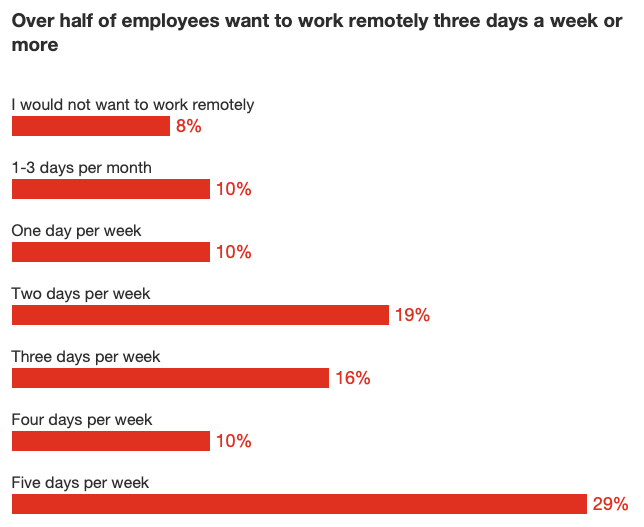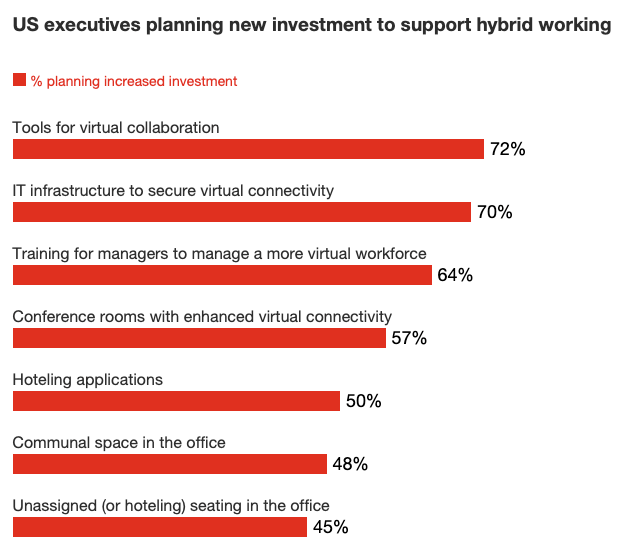For the past 14 months, the way we work has been turned completely upside down. But as it becomes increasingly safer to share space and work together in person, many companies are gearing up for a return to normalcy—and getting back to what work looked like before COVID.
But the truth is, some of the changes we’ve experienced over the past year? They’re not going anywhere. In many ways, work will never be the same, and if companies want to thrive moving forward, they need to understand what elements of work have changed for good—and how to adjust their strategy and approach to cater to those changes.
So, in what ways will work never be the same—and what does that mean for businesses?
Requiring people to work in the office full-time
COVID-19 forced many companies to shift entirely to remote operations—including companies that, prior to the pandemic, had strict policies that required their teams to work in the office at all times.
But while many companies are welcoming (or preparing to welcome) their teams back to the office, now that they’ve experienced the flexibility of remote work, many employees are no longer interested in working in the office full-time.
And, because of that, where we work will never be the same.
Also read: Are We Witnessing The Death Of The Office?
According to the recent US Remote Work Survey from PwC, nearly three out of four employees (74 percent) want to continue working from home at least two days per week. Essentially, employees want to move towards a hybrid work environment, where they spend some of their time working remotely and some of their time working in the office—and if companies want to stay competitive, they’ll need to provide that kind of flexibility to their employees.

PwC’s US Remote Work Survey (2021)
Will there be companies that require their employees to return to the office full-time? Of course. But, moving forward, flexible work options are going to play a huge role in attracting and retaining top talent—so expect a majority of companies to move away from strict work requirements and towards a hybrid work model.
Also read: [Expert Opinion] Bertrand Duperrin: Toward a Hybrid Work Model
Office design
As mentioned, at this point, there’s no going back when it comes to flexible work options. And in response to so many companies moving towards a hybrid work environment, there is another area of work that’s poised to go through a major shift—and that’s office design.
In order to set themselves up for success with this new model of work, companies will need to rethink their offices—and redesign them in a way that supports their hybrid workforce. For example, according to PwC’s US Remote Work Survey, a huge majority of executives are planning to increase spending to better equip their offices to support hybrid work—including investing in tools for virtual collaboration (72 percent), IT infrastructure to secure virtual connectivity (70 percent), conference rooms with enhanced virtual connectivity (57 percent), and creating more flexible, communal workspaces within the office (48 percent).

PwC’s US Remote Work Survey (2021)
The point is, the office of yesterday isn’t going to support the workforce of tomorrow—so companies will need to rethink their office design to set themselves and their teams up for success.
Also read: [Expert opinion] New Office Design Trends For 2021
Making employee wellness an afterthought (or not a thought at all)
While recent years have brought an increased interest in employee health in the workplace, for many organizations, supporting their employee’s physical and mental well-being wasn’t a top priority (or a priority at all).
Also read: Human Resources: 5 Priorities for 2021 According to Gartner
But the pandemic has shifted the way employees think about their own health—and the expectations they have for their companies to support their well-being. According to a recent survey from Aetna International, a large majority of employees say their physical health (89 percent) and mental health (84 percent) is more important to them now than it was a year ago. Moreover, 65 percent of employees reported they would only return to the office if their employer changed their policies around workplace well-being.
So, moving forward, not having a clear strategy on how you’re going to support your employees’ physical, mental, and emotional health is no longer an option. The organizations that will end up being the most successful will be the one that invest their time, energy, and resources into employee wellness. That includes things like access to quality health care, creating work-life balance (including the right to disconnect, which respects employee boundaries outside of work hours), wellness-centric office design (for example, having a “quiet room” for employees to meditate or take a break when they’re feeling overwhelmed), and wellness initiatives, both for in-person and remote employees.
Also read: Changing Work Modes: What Role Does Quality of Work Life Play?
Business travel
Employees want to get back to business travel. According to the Business Traveler Sentiment Survey from GoldSpring Consulting, 63 percent of business travelers want to return to business travel in the next six months—and 70 percent want to resume business travel by the end of the year.
But just because many employees feel ready (or almost ready) to resume business travel doesn’t mean that businesses will resume travel at the rate they were operating before the pandemic.
Business travel is a major expense; for every trip a business traveler takes, the company has to foot the bill for everything from flights and accommodations to transportation and food. And because the pandemic forced companies to navigate their business dealings and relationships without any travel, many realized their teams could get just as much done working remotely—no expensive travel bill required.
Now, business travel, as a whole, isn’t going anywhere; there will always be situations where companies need to send their employees on business-related trips. But there’s no denying that the pandemic shifted the way that companies think about business travel. Moving forward, expect companies to take a significantly more stringent approach to what business travel is essential (and what could be managed with video conferencing and other virtual work tools).
*
* *
The pandemic shifted the way we look at, think about, and approach work—and many of those changes will be permanent. But now that you know some of the ways work will never be the same, you can adjust your organizational strategy accordingly—and set your business and team up for success as we move into this new era of work.
Do you want to learn more about hybrid work? Read our white paper on this topic:
Access White Paper
In our white paper “Future of Work: Make Way for Hybrid Work!” you’ll discover the eight main challenges of hybrid work; best practices managers, HR, internal communication, IT and employees all can adopt; and the tools for facilitating hybrid work.
–
Author: Deanna deBara



